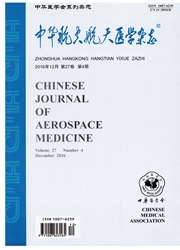

 中文摘要:
中文摘要:
目的 研究空降兵在不同高度以半蹲式着陆时,内、外踝关节的最大应力关系. 方法 18名男性伞兵穿06伞兵作训靴,踝关节佩戴贴片式应力传感器,分别从60 cm及150 cm两种不同高度平台跳落,模拟空降兵跳伞半蹲式着陆,检测比较内、外踝关节所受的最大应力. 结果 60 cm高度模拟空降兵跳伞半蹲式着陆,双足内踝最大应力平均值为328.71 kPa,外踝最大应力平均值为205.92 kPa,内踝最大应力平均值显著大于外踝最大应力平均值(t=4.005,P<0.01).150 cm高度模拟空降兵跳伞半蹲式着陆,双足内踝最大应力平均值为365.39 kPa,外踝最大应力平均值为77.28 kPa,内踝最大应力平均值显著大于外踝最大应力平均值(t=13.935,P<0.01). 结论 模拟空降兵跳伞半蹲式着陆时,高度对内踝最大应力平均值大于外踝最大应力平均值的现象没有明显影响.双足内踝最大应力大于双足外踝最大应力是导致伞兵足过度内翻,甚至造成踝关节损伤的主要生物力学机制.
 英文摘要:
英文摘要:
Objective To study the internal and external maximum malleolus stresses when they landing from different heights with squat-style.Methods The subjects were 18 male professional paratroopers,wearing military special parachute boots,respectively jumped from 60 cm and 150 cm height platforms and landed with squat-style attitude to test their internal and external maximum malleolus stresses.Results For 60 cm height jumping,the average maximum stress of internal malleolus was 328.71 kPa,the average maximum stress of external malleolus was 205.92 kPa,the average maximum stress of internal malleolus was significantly greater than that of the external malleolus (t=4.005,P〈0.01).For 150 cm height jumping,the average maximum stress of internal malleolus was 365.39 kPa,the average maximum stress of external malleolus was 77.28 kPa.The average maximum stress of internal malleolus was significantly greater than that of the external malleolus (t=13.935,P〈0.01).Conclusions The height does not significantly affect the variation of internal and external maximum malleolus stress as the paratroopers landing with squat-style.The left and right maximum internal malleolus stress is respectively greater than the left and right maximum external malleolus stress.The stress differences lead to paratroopers' excessive foot pronation and are the major biomechanical mechanisms that caused ankle injury.
 同期刊论文项目
同期刊论文项目
 同项目期刊论文
同项目期刊论文
 期刊信息
期刊信息
